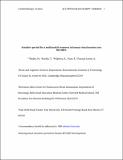Sensitive Period for a Multimodal Response in Human Visual Motion Area
Author(s)
Pelphrey, Kevin; Pascual-Leone, Alvaro; Bedny, Marina; Konkle, Talia A.; Saxe, Rebecca R.
DownloadSaxe-2010-Sensitive Period.pdf (1.953Mb)
OPEN_ACCESS_POLICY
Open Access Policy
Creative Commons Attribution-Noncommercial-Share Alike
Terms of use
Metadata
Show full item recordAbstract
The middle temporal complex (MT/MST) is a brain region specialized for the perception of motion in the visual modality [ [1], [2], [3] and [4]]. However, this specialization is modified by visual experience: after long-standing blindness, MT/MST responds to sound [5]. Recent evidence also suggests that the auditory response of MT/MST is selective for motion [ [6] and [7]]. The developmental time course of this plasticity is not known. To test for a sensitive period in MT/MST development, we used fMRI to compare MT/MST function in congenitally blind, late-blind, and sighted adults. MT/MST responded to sound in congenitally blind adults, but not in late-blind or sighted adults, and not in an individual who lost his vision between ages of 2 and 3 years. All blind adults had reduced functional connectivity between MT/MST and other visual regions. Functional connectivity was increased between MT/MST and lateral prefrontal areas in congenitally blind relative to sighted and late-blind adults. These data suggest that early blindness affects the function of feedback projections from prefrontal cortex to MT/MST. We conclude that there is a sensitive period for visual specialization in MT/MST. During typical development, early visual experience either maintains or creates a vision-dominated response. Once established, this response profile is not altered by long-standing blindness.
Date issued
2010-10Department
Massachusetts Institute of Technology. Department of Brain and Cognitive SciencesJournal
Current Biology
Publisher
Elsevier Ltd.
Citation
Bedny, Marina et al. “Sensitive Period for a Multimodal Response in Human Visual Motion Area MT/MST.” Current Biology 20.21 (2010): 1900–1906. Web. 13 Apr. 2012. © 2010 Elsevier Ltd.
Version: Author's final manuscript
ISSN
0960-9822